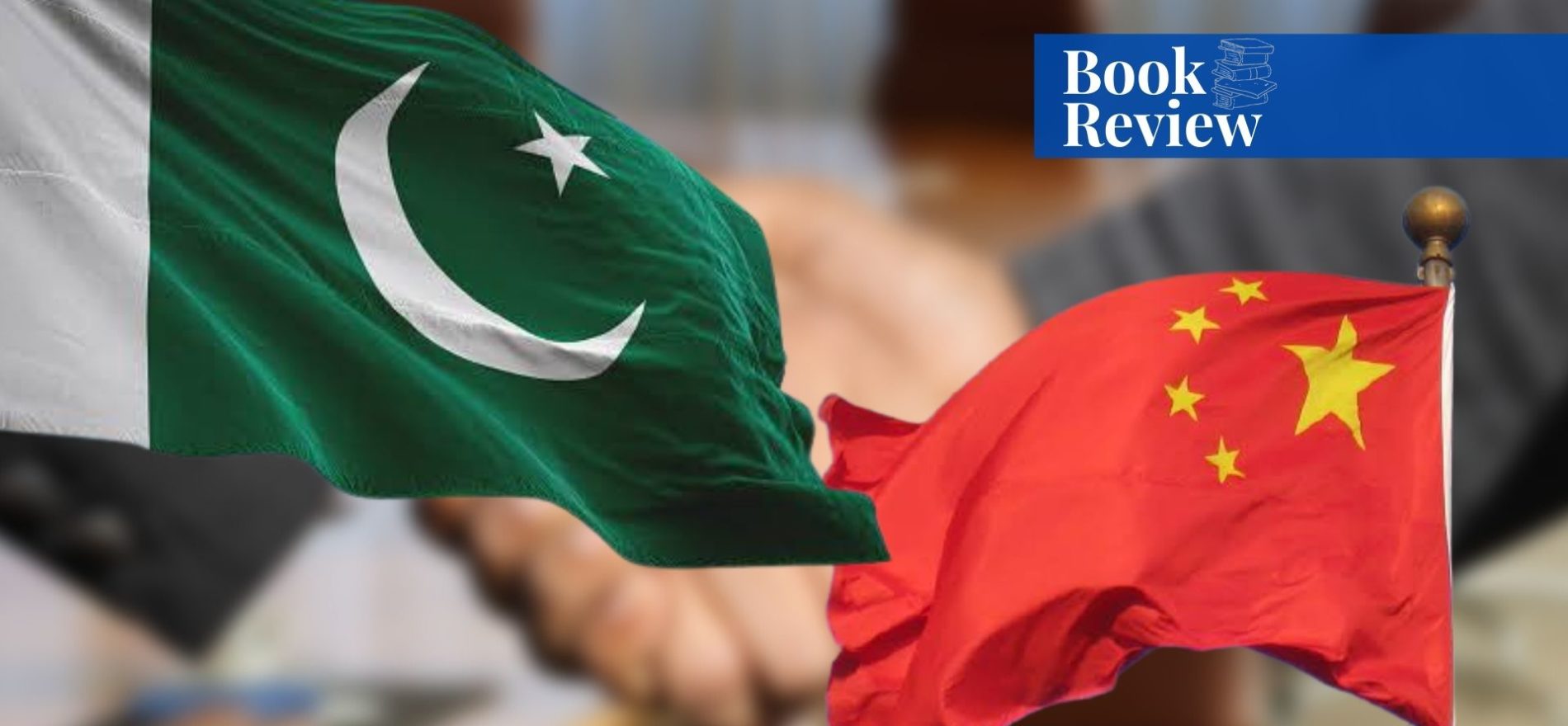Muhammad Abubaker has done his bachelor's in international relations from Bahria University, Islamabad. IHis publications include a piece titled "The emergence of a new Cold War mentality and the role of Quad" and a policy paper titled "The US security leadership in Asia-Pacific and China's countermeasures".
Introduction to the Book
The book “China-Pakistan Axis: Asia’s New Geopolitics” was written by Andrew Small. The title suggests that the book is written in the context of geographic factors and the impact of geography on the political relations between both states. However, both Pakistan and China have been in a geopolitical relationship since their existence but what is notable in the title of this book is the word “new” which grabs the attention of the reader. “New,” in this book, seems to be indicating how through the events in history this relation has become more complex and is different from what it started off as.
Andrew Small’s China-Pakistan Axis is non-fiction and based on real events and facts. It can, without a doubt, be called an extraordinary and outstanding piece of research. Andrew Small has lent his hands to some really secretive and highly sensitive information about the events of the Sino-Pakistan relationship.
As one goes on reading the book, one apprehends that the author has had remarkable access to the political, military, and intelligence officials in both countries. This book explores some really under-explored areas of the China-Pakistan “friendship”. China-Pakistan Axis provides huge data on the Sino-Pakistan relationship and is the first in-depth work on this relation. Its reliability is assured by years of research and interface with officials on both sides of the margin.
Andrew Small’s China-Pakistan Axis: Asia’s New Geopolitics has a total of seven chapters and an epilogue that collectively covers all important aspects of the past and present Sino-Pakistan relations. Small’s choice of quotation before every chapter is remarkable and explains half the truth about the title of each chapter and also makes the reader stick to the book and develop curiosity. Hence, China-Pakistan Axis is not only a masterpiece of research but is also well written in terms of literature.
Synopsis of Andrew Small’s “China-Pakistan Axis”
A Friendship Forged by War
The first chapter – “A Friendship Forged by War” – reflects upon the reality behind what is seen and shown internationally as “friendship” or “brotherly ties” formed on the basis of the neighborhood and common enmity towards India. The China-Pakistan friendship starts with the 1971 Indo-Pakistan War, laying out how China remained, to a great extent, on the sidelines in spite of the US and Pakistani appeals.
The starting points of Pakistan’s misrepresented desires for Chinese help in 1971 evolved from the 1965 Indo-Pakistan War, in which the possibility of Chinese interference played an essential role. Regardless of early variations between the opposite sides, the 1962 Sino-Indian War was the vital motivation for the relationship and opened up the possibility of a “two-front war” that has never completely subsided from the area’s key environment.
Nuclear Fusion
The second chapter, “Nuclear Fusion,” covers the touchy history of atomic collaboration between China and Pakistan. It sheds light upon why China wants a stable Pakistan. As collaboration increased in the mid-1980s, the US declined to obstruct atomic participation among Pakistan and China on the grounds that both were apparently partners against the Soviet Union.
While Pakistan has profited the most from the relationship, mainly from the security ensured atomic weapons, China keeps on profiting shrewdly from Pakistan’s exchange of touchy Western innovation. The chapter additionally covers how the common strategic concern – India – has been strengthening the military ties between Pakistan and China. Small states, “If military relationships lie at the heart of China-Pakistan ties, nuclear weapon lies at the heart of the military relationship.”
Re-hyphenating India
The third chapter, “Re-hyphenating India,” mapped the development of Chinese key thinking about the role of Pakistan which starts with reviewing the 1996 Pakistan visit of Chinese President Jiang Zemin and 2008 wrangling over the permission of India into the Nuclear Supplier Group (NSG). It argues that, if the US’ way of dealing with India, in the course of the most recent decade, has been one of de-hyphenation from Pakistan, China’s has been one of re-hyphenation.
Since the nuclearization of South Asia in the late 1990s, Washington and Beijing have been bound together in their endeavors to prevent full-scale war on the subcontinent. The Kargil War in 1999, writes Small, is proof of this dynamic. During that clash, China declined to help Pakistan and Beijing coordinated with Washington to guarantee the de-heightening of the emergency.
Regardless of coordination with the US during times of emergency, China has proceeded atomic collaboration with Pakistan over the US and global resistance as an appearance of China’s technique of utilizing Pakistan to adjust against India.
The Chinese War on Terror
The fourth chapter, “The Chinese War on Terror,” talks about the issue of Xinjiang and Islamic terrorism in China. It traces the historical backdrop of the issue and subtle elements of the risk presented by the East Turkistan Islamic Movement (ETIM) to China, which has on occasion been recognized as the principal danger to the soundness of the Chinese state.
One of China’s methodologies to contain the danger of ETIM and other Uighur activist gatherings has been to extend associations with Pakistani religious associations with an end goal to disengage ETIM and its comparative associations. China worked with the United States and Saudi Arabia to arm the mujahedeen powers in Pakistan against the Soviet Union in the 1980s, however, in the 1990s, China turned out to be progressively awkward with developing fanaticism in the area.
China has utilized its impact on Pakistan to limit support from Pakistani and Afghan Islamic gatherings for the Uighur cause, even going into an inferred consent to help the Taliban in Afghanistan in return for keeping ETIM from working on Afghan soil. Anyway as fanatics’ ties with the Pakistani state have crumbled as of late, China progressively faces a quandary about how to face the risk of Islamic psychological warfare.
The Trade Across the Roof of the World
The fifth chapter is “The Trade Across the Roof of the World” which talks about the Sino-Pakistan relationship with reference to economic ties. The Sino–Pakistan monetary relations have been, extensively, disappointing. Uncertainty in Pakistan has represented a noteworthy hazard to the general financial relationship since Pakistan has picked up a notoriety for being the most unsafe nation on the planet for the Chinese.
The section talks about the job and issues with the Karakoram Highway, which has been proposed as the foundation of an exchange and vitality hallway from the inside of China to the port of Gwadar on the Persian Gulf. Gwadar itself has not been created to the degree that was guaranteed at first, owing to the Baloch militancy to some extent. Nevertheless, China sees the port as a possibly significant maritime office.
Tea with Taliban
The sixth chapter, “Tea with Taliban,” follows the historical backdrop of Sino-Afghan relations, concentrating on China’s association with the Taliban and connections with Afghanistan in the repercussions of 9/11. This part examines the job of the Aynak mine in Sino-Afghan relations, yet contends that China’s choice to assume liability for impacting the political and security circumstance in Afghanistan did not come from its interests in the nation, but instead, from fears that mayhem in Afghanistan could overflow into Pakistan and Xinjiang.
In the 1990s, China kept up great relations with the Taliban government with the end goal to keep Afghanistan from turning into a shelter for ETIM activists, and in the 2000s, it tried to abstain from taking sides between the US-drove powers and the insurrection. The chapter takes a gander at the movements in China’s position as fears over vital enclosure by US powers moved to fears over the 2014 result.
Lord, Make Them Leave…But Not Yet
The seventh chapter, “Lord, Make Them Leave…But Not Yet,” starts by depicting how the US exploits wiped out a large number of China’s most-needed Muslim separatists in Pakistan starting in 2009. This part portrays how China’s general system has been to guarantee that it doesn’t get on the wrong side of the fanatics, which has regularly put China inconsistent with the United States.
This part develops the ongoing history of how China has moved its situation on fanaticism in South Asia and turned out to be more okay with the possibility of the United States proceeding to give security in Afghanistan. It investigates the cutoff points of the Sino–US participation, including a speculative seizure of the Pakistani atomic weapons on account of the state destabilizing.
In the wake of the execution of Osama Bin Laden, Pakistan became more inclined towards China as its relations with Washington plunged. In the meantime, Chinese authorities were guaranteeing their US partners that they shared worries about Pakistan’s fanatic issue and would not “refill for the Americans.” Furthermore, as of late, China has been more helpful to the US in its work to desert a steady and secure Afghanistan.
Conclusion
Andrew Small’s China-Pakistan Axis: Asia’s New Geopolitics explores the reality of the Sino-Pakistan relationship by explaining that at each event, it has been a relationship of mutual benefit, and both of the countries have put themselves and their defense ahead of everything else, which is accurate to a great extent. Even if China has supported Pakistan at some points it has been because China had its own interests invested in that particular action.
To gain an in-depth analysis of the Sino-Pakistan relationship, I would definitely recommend this informative read. It takes you through all of the phases of history that these two countries have been through, without any biases.
If you want to submit your articles, research papers, and book reviews, please check the Submissions page.
The views and opinions expressed in this article/paper are the author’s own and do not necessarily reflect the editorial position of Paradigm Shift.



















